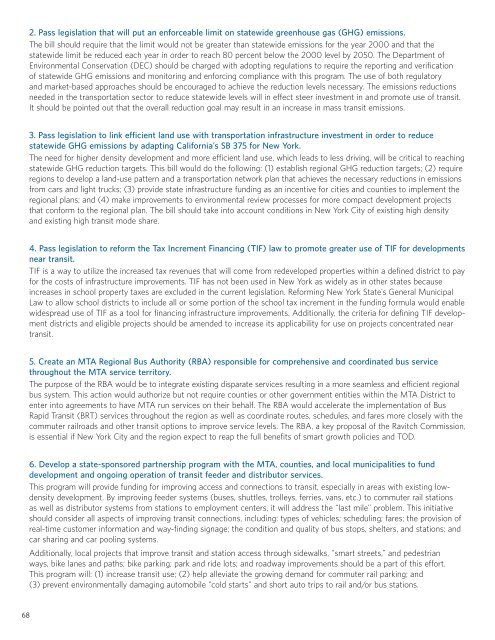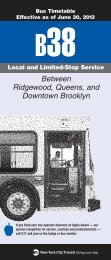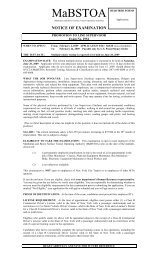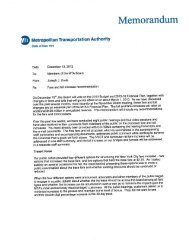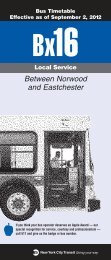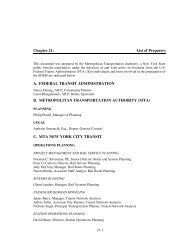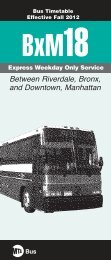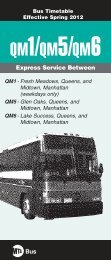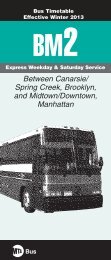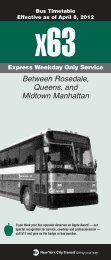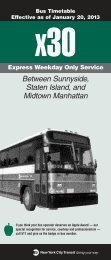Greening Mass Transit & Metro Regions: The Final Report - MTA
Greening Mass Transit & Metro Regions: The Final Report - MTA
Greening Mass Transit & Metro Regions: The Final Report - MTA
You also want an ePaper? Increase the reach of your titles
YUMPU automatically turns print PDFs into web optimized ePapers that Google loves.
68<br />
2. Pass legislation that will put an enforceable limit on statewide greenhouse gas (GHG) emissions.<br />
<strong>The</strong> bill should require that the limit would not be greater than statewide emissions for the year 2000 and that the<br />
statewide limit be reduced each year in order to reach 80 percent below the 2000 level by 2050. <strong>The</strong> Department of<br />
Environmental Conservation (DEC) should be charged with adopting regulations to require the reporting and verification<br />
of statewide GHG emissions and monitoring and enforcing compliance with this program. <strong>The</strong> use of both regulatory<br />
and market-based approaches should be encouraged to achieve the reduction levels necessary. <strong>The</strong> emissions reductions<br />
needed in the transportation sector to reduce statewide levels will in effect steer investment in and promote use of transit.<br />
It should be pointed out that the overall reduction goal may result in an increase in mass transit emissions.<br />
3. Pass legislation to link efficient land use with transportation infrastructure investment in order to reduce<br />
statewide GHG emissions by adapting California’s SB 375 for New York.<br />
<strong>The</strong> need for higher density development and more efficient land use, which leads to less driving, will be critical to reaching<br />
statewide GHG reduction targets. This bill would do the following: (1) establish regional GHG reduction targets; (2) require<br />
regions to develop a land-use pattern and a transportation network plan that achieves the necessary reductions in emissions<br />
from cars and light trucks; (3) provide state infrastructure funding as an incentive for cities and counties to implement the<br />
regional plans; and (4) make improvements to environmental review processes for more compact development projects<br />
that conform to the regional plan. <strong>The</strong> bill should take into account conditions in New York City of existing high density<br />
and existing high transit mode share.<br />
4. Pass legislation to reform the Tax Increment Financing (TIF) law to promote greater use of TIF for developments<br />
near transit.<br />
TIF is a way to utilize the increased tax revenues that will come from redeveloped properties within a defined district to pay<br />
for the costs of infrastructure improvements. TIF has not been used in New York as widely as in other states because<br />
increases in school property taxes are excluded in the current legislation. Reforming New York State’s General Municipal<br />
Law to allow school districts to include all or some portion of the school tax increment in the funding formula would enable<br />
widespread use of TIF as a tool for financing infrastructure improvements. Additionally, the criteria for defining TIF development<br />
districts and eligible projects should be amended to increase its applicability for use on projects concentrated near<br />
transit.<br />
5. Create an <strong>MTA</strong> Regional Bus Authority (RBA) responsible for comprehensive and coordinated bus service<br />
throughout the <strong>MTA</strong> service territory.<br />
<strong>The</strong> purpose of the RBA would be to integrate existing disparate services resulting in a more seamless and efficient regional<br />
bus system. This action would authorize but not require counties or other government entities within the <strong>MTA</strong> District to<br />
enter into agreements to have <strong>MTA</strong> run services on their behalf. <strong>The</strong> RBA would accelerate the implementation of Bus<br />
Rapid <strong>Transit</strong> (BRT) services throughout the region as well as coordinate routes, schedules, and fares more closely with the<br />
commuter railroads and other transit options to improve service levels. <strong>The</strong> RBA, a key proposal of the Ravitch Commission,<br />
is essential if New York City and the region expect to reap the full benefits of smart growth policies and TOD.<br />
6. Develop a state-sponsored partnership program with the <strong>MTA</strong>, counties, and local municipalities to fund<br />
development and ongoing operation of transit feeder and distributor services.<br />
This program will provide funding for improving access and connections to transit, especially in areas with existing lowdensity<br />
development. By improving feeder systems (buses, shuttles, trolleys, ferries, vans, etc.) to commuter rail stations<br />
as well as distributor systems from stations to employment centers, it will address the “last mile” problem. This initiative<br />
should consider all aspects of improving transit connections, including: types of vehicles; scheduling; fares; the provision of<br />
real-time customer information and way-finding signage; the condition and quality of bus stops, shelters, and stations; and<br />
car sharing and car pooling systems.<br />
Additionally, local projects that improve transit and station access through sidewalks, “smart streets,” and pedestrian<br />
ways, bike lanes and paths; bike parking; park and ride lots; and roadway improvements should be a part of this effort.<br />
This program will: (1) increase transit use; (2) help alleviate the growing demand for commuter rail parking; and<br />
(3) prevent environmentally damaging automobile “cold starts” and short auto trips to rail and/or bus stations.


